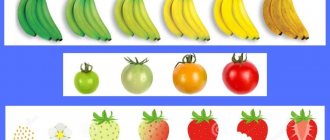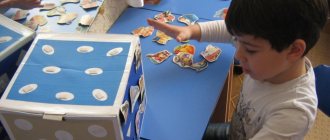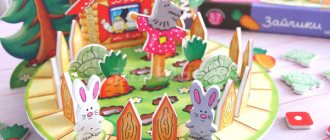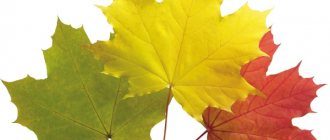Didactic games “Trees” in the younger group
We offer simple and exciting games that help younger preschoolers get acquainted with the world of flora.
One, two, three - hug the tree!
It is better to play outdoor games in a park where there are many different plants. The presenter names a tree of a certain type, says: “One, two, three - hug the tree!” Children look for the plant named by the leader, and when they find it, they run up to it and clasp it with their hands.
Find the odd one out
The game is designed to develop visual perception and observation skills. First hang natural objects that are not related to them on the plants growing in the yard. For example, on a birch - an acorn, on a fir tree - a maple leaf, on an oak - a pine cone. The task of preschoolers going out for a walk is to carefully examine the plants and find the odd one out.
Crafts
The activity develops imagination and creativity. For the game, collect natural materials: cones, fallen leaves, seeds, birch catkins, pieces of bark, acorns, maple “spouts”. Invite students to make crafts from the collected material. Each child creates some kind of appliqué, painting, three-dimensional composition. Then he tells what parts of the tree he used to create the artwork. At the end of the lesson, you can make an exhibition of children's works with discussion.
Wood parts
The activity develops memory and thinking abilities. Younger preschoolers will learn the names of plant parts.
Print out a realistic image of a tree, tell the children what a trunk, branches, roots are, explain that the collection of leaves is the crown. During the explanation, children should look at the picture.
LiveInternetLiveInternet
Flashcards - Trees
Dear Teachers!
I offer you didactic material for classes. Let's pose the children with different trees.
Print out sheets of trees, their leaves, seeds, and a brief description of each tree. Each tree comes with pictures of leaves that can be colored. Teach children to remember what twigs, leaves and fruits look like.
I also offer you a sample of composing a short story about a birch (by analogy, you can compose the same stories about other trees) and several riddles about trees (read below).
In a brief description of each tree, you can find out their features, what they look like, where they grow, age, and interesting facts about the tree.
A story about Birch:
This is a birch tree. She has a white, thin, slender trunk. The branches have round leaves. The birch tree feeds with the help of its roots. Birch is a large deciduous tree. Most often it grows in the forest. In the city, people plant birch trees to make the air clean. Various crafts are made from birch bark. In spring, buds appear on the birch tree and turn into leaves. The birch tree remains green all summer. In autumn the leaves turn yellow and fall off. In winter, bare branches are covered with snow.
Questions about Tree:
What trees do you know?
Are trees different from shrubs? How?
Are trees living or non-living?
Who (or what) helps them grow?
What should I water them with: water or milk?
(Show pictures of trees) What is the name of this tree? How big is it? Where does it most often grow?
What parts does it consist of?
How can it benefit people?
How does it change at different times of the year?
What can be made from this tree?
Why do people plant trees on city streets?
What are trees for, benefits of trees:
Trees purify and humidify the air, create coolness, and some produce delicious edible fruits.
Sawn wood is a building material: dried trunks are used to make boards, plywood, furniture, toys, and paper.
Trees grow slowly, so they need to be protected.
We need to protect the trees, take care of them, sometimes talk to them kindly, and in the spring, plant young trees together with our parents.
Tasks in which you need to write the names of trees by guessing their leaves.
TREE STRUCTURE - a tree with a clearly defined trunk, lateral branches and apical shoot. The components of a tree are the crown, trunk and roots.
Riddles about Trees: *** It makes you happy in the spring, it cools you in the summer, it nourishes you in the fall, it warms you in winter. (Tree) *** Like pine trees, like fir trees, And in winter without needles. (Larch) *** She turned green in the spring, tanned in the summer, and wore red corals in the fall. (Rowan) *** A Russian beauty is standing in a clearing, wearing a green blouse and a white sundress. (Birch) *** She lowered her curls into the river And became sad about something, And what she is sad about, She doesn’t tell anyone. (Willow) *** You will find her in the forest, Let's go for a walk and meet her. Stands prickly, like a hedgehog, In winter in a summer dress. (Spruce) *** In summer - snow! Just laughter! Snow is flying around the city, why doesn't it melt? (Pople fluff) *** No one is scared, but everyone is trembling. (Aspen)
Didactic games "Trees" in the middle group
Games intended for the middle age group continue to introduce preschoolers to the signs and characteristics of different trees, foster curiosity, broaden their horizons, develop speech skills and the ability to think logically.
What grows on what?
The presenter begins the phrase, and the players logically continue:
- there are... apples hanging on the apple tree;
- there are... earrings hanging on the birch tree;
- there are... nuts hanging on the hazel tree;
- there are... acorns hanging on the oak tree;
- there are... pine cones hanging on the tree.
Make up a picture
For the game, prepare pictures depicting trees familiar to preschoolers, cut them into several arbitrary parts. Hand out the cut images to the children and ask them to put the parts of the picture together into a single whole. Having completed the task, the child carefully examines the picture, says what plant he sees, and describes it. For example: “This is oak. He's big and strong. This is a forest tree. There are acorns hanging on it.”
Guess by description
The presenter names a list of signs, and the children try to guess what plant they are talking about:
- slender, with a white trunk, with earrings, curly, thin - birch;
- prickly, triangular, covered with needles, with wide legs, green in winter - a Christmas tree;
- strong, with a thick trunk, with acorns on the branches, with a wide crown, centuries-old - oak;
- weeping, slender, with long branches, bending over the water - willow;
- beautiful in autumn, with large carved leaves - maple.
Say an adjective
The presenter says the name of the tree, and the players take turns calling the defining adjective:
- birch, and the sap... birch;
- pine, and the cone... pine;
- aspen, and the leaf... is aspen;
- oak, and the furniture... oak;
- poplar, and the fluff... poplar;
- bird cherry, and the color... bird cherry;
- apple tree, and jam... apple;
- linden, and honey... linden;
- spruce, and the paw... is spruce.
Good or bad
Have the players split into two groups. The first in line should name everything that benefits the trees. For example, watering, sun, rain, fertilizer, bees, heat. The latter call what is harmful to plants. For example, insects, fire, cold, frost, heat, drought. It is important that children explain their opinions in detail.
Didactic games “Trees” in the senior group
In the older group, preschoolers learn to distinguish, describe, classify, their ideas about the world around them expand, and speech skills develop.
Tell me about the leaf
The game teaches how to compose complex sentences; preschoolers' understanding of colors and shapes expands. For the activity, prepare dried leaves of different types of trees familiar to the children. Or print realistic images. Each student takes turns choosing the piece of paper that he likes more than the others and tries to describe it in detail.
Find a tree
It is better to play the game in a park where there are many different types of flora familiar to preschoolers. Children look at the plants around them, while listening carefully to the teacher. And he talks about the tree without naming it. Based on the description they hear, children must guess what plant they are talking about. For example, here is a description of the rowan: “A slender tree with long and narrow leaves, collected together in several pieces. In autumn, berry clusters form on the branches. The berries are small and red; bullfinches love to feast on them.”
I am a tree
Outdoor play promotes physical development, stimulates imagination, and broadens one's horizons. Before class, discuss with your students that trees come in different shapes and sizes: with a narrow and wide crown, with branches pointing up or down. Let the students imagine that they are trees: their arms are branches, their legs are roots, their torso is a trunk. Each child imagines himself to be a plant of a certain type, but does not say what kind.
Each player takes turns standing in front of his comrades, using gestures and body movements to depict the tree and what is happening to it. The other players guess what their friend is trying to show. For example, when imitating an oak tree, a child demonstrates that he is strong, spreads his legs, sticks out his chest, and makes sounds that imitate the rustling of leaves in the wind, the chirping of birds on the branches. When depicting a willow, the player makes a sad face, imitates crying, and limply lowers his hands.
What's extra?
The game teaches you to classify plants according to key characteristics. For the lesson, make cards, each of which should depict 4 types of trees, one of which belongs to another category.
Players look at the images one by one, identify the odd plant, and select a unifying category for the rest. If the player makes a mistake, the right to move is transferred to the next child. The one who correctly identified the extra tree gets a point. The winner is the one who scores the most points.
Here are examples for the game:
- maple, aspen, spruce, poplar - category of deciduous species;
- spruce, cedar, pine, chestnut - coniferous species;
- aspen, pear, cherry plum, apple tree - fruit crops;
- lilac, birch, jasmine, bird cherry - shrubs.
Fly to me, leaf
For active play, you need dried fallen leaves of different types and silhouette views of the same leaves. Players receive silhouettes one at a time. The teacher stands at the other end of the room and shows the dried leaves to the children. For example, he shows a maple leaf and calls: “Fly to me, maple leaf.” The player, who sees the corresponding outline, runs up to the teacher and talks about the features characteristic of the tree to which the demonstrated leaf belongs.
The game can be complicated by not naming the type of plant, but simply saying: “Fly a leaf to me.” Then the child, who has discovered the corresponding contour, must himself determine the species of the tree, then talk about it.
Didactic game "Trees"
Didactic game “Number. Sign. Subject" on the lexical topic "Trees"
The game is intended for children aged 4-6 years with severe speech impairments, as well as for children of preschool and primary school age to develop the lexical and grammatical structure of speech.
Didactic game “Number. Sign. Subject" can be used both in individual and subgroup lessons with children.
Target:
This set of games will help an adult teach a child:
- agree nouns with numerals and adjectives in gender, number, case;
- select qualitative, relative, possessive adjectives for nouns;
- use ordinal numbers in speech, coordinate them with nouns and adjectives in gender, number, case;
- activate mental activity, associative thinking;
- make comparative sentences with the conjunction “a”.
Material for the game:
cards with game tasks in two subjects of the same lexical group; playing field and cut cards for independent selection and compilation of a plot series; sets of numbers.
Game description:
Game with ready-made models: each table contains tasks for two subjects of the same lexical group for a larger educational load. At the beginning of the game, the child needs to be clearly shown how associations can be used to indicate the characteristics of objects. For example, how can you depict a bitter taste, show the hardness, softness, juiciness of vegetables, color and shape.
Below are ready-made game cards:
- two tall slender birches;
- five tall oval linden trees;
- one tall slender alder;
- three tall strong oak trees;
- one low slender aspen;
- four low round maples;
- three green triangular spruce trees;
- six green tall pines;
The game requires compliance with the following steps:
- Name a word denoting a number (what number? - two).
- Name the word denoting the object (what is it? - birch).
- Agree the noun with the numeral in gender (how many birches? - two birches).
- Name the words denoting the attribute of an object, coordinate them with numerals and nouns in gender, number (two birch trees (which ones?) - tall, slender).
- Agree the numeral with the adjectives and nouns in gender and number. (Say in a complete sentence, starting with the number. – Two tall slender birch trees.)
- Using the same principle, consider another subject of the lexical group - linden.
- Make comparative sentences with the conjunction “a”. (Birch trees - two, linden trees - five, etc.)
Game with cut cards : played on the same principle as with ready-made models. Only here the child takes an active position and is given more independence.
First, you should invite the child to choose an item on a lexical topic and place it in a sector with an asterisk, then a number (place in the first sector) and select adjectives in the form of picture symbols (place in the longest sector of the playing field). The symbol pictures are first reviewed and what they mean is explained.
To better understand the progress of the game with cut cards, a sample is provided below.
Using the didactic game “Number. Sign. Subject" children will quickly master the skills of agreeing adjectives, nouns and numerals in gender, number, case; will learn to select adjectives for nouns and develop their associative thinking.
The development of associative thinking has a positive effect on the process of memorizing and reproducing necessary information.
On our website you can find other educational games from the “Number” series. Sign. Item". To do this, follow the highlighted link .
We wish everyone success.
Didactic games “Trees” in the preparatory group
The presented games expand the understanding of plant species, develop imagination and thinking abilities, and form basic mathematical and lexical knowledge.
Trees
The purpose of the didactic game “Trees” is to get acquainted with the diversity of flora and teach the skill of identifying and distinguishing plants. The game is played in the form of a lotto, it requires 24 cards depicting different types of flora, and 4 playing fields, divided into 6 cells with images of the corresponding plants.
The presenter distributes the playing fields to the players. Then he shows the cards one by one and names the plant depicted. The child who finds the corresponding image on his field receives a card. The game ends when one of the players covers all the cells of the field with pictures, he becomes the winner. But before this, the player must name the category that includes the plants on his field. For example:
- aspen, poplar, maple, chestnut, linden, rowan - deciduous species;
- jasmine, lilac, sea buckthorn, hawthorn, bird cherry, mimosa - shrubs;
- spruce, cedar, juniper, pine, thuja, cypress - conifers;
- Apple, apricot, plum, cherry plum, pear, cherry are fruit crops.
Didactic game “Which tree is the leaf from?”
For the game, prepare cards on which trees of 4 different types are depicted at the top, and 4 leaves below them. For example, at the top are images of maple, aspen, birch, and rowan, and below them are aspen, rowan, maple, and birch leaves. Ask the student to correctly connect the plants with leaves: draw lines between them.
What is a tree?
The presenter begins a phrase on the importance of plants for living beings and people, and the players take turns continuing:
- a tree for birds is... a home, a resting place, a place to build a nest, a feeder;
- for painters - an artistic object, the basis of a landscape, an object of inspiration;
- for beetles - housing, food, place of laying eggs, place of hibernation;
- for travelers - a place of rest, protection from the scorching sun;
- for builders - material for building houses;
- for carpenters - material for making furniture.
Trees
The game is recommended not only for preschoolers in the preparatory group, but also for younger schoolchildren with speech impediments. For the lesson you need sets of cards of 4 categories: numbers from 1 to 10, two options for signs and the trees themselves. From the cards presented, the child makes sentences that he pronounces out loud. First, you should show your preschooler how to do this. The first card in a row is laid out with a number, then a picture of a plant, and at the end there are 2 cards with characteristics.
For example, a child posts the number 3 and a picture of an aspen tree. Pronounces: “Three aspens.” Between these cards he places symbolic images of the characteristics of the object: tall and slender. Says the full sentence: “Three tall slender aspen trees.”







